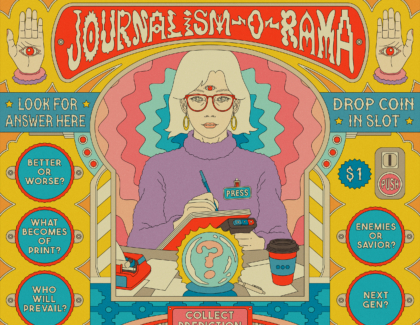Sign up for the daily CJR newsletter.
I was at Harvard for two conferences last week: one on gender bias in the technology industry, the other on fighting disinformation in news. While I was at the tech conference, tweeting out notes on presenters’ data-driven studies of gender in the industry, I also composed a Twitter thread on the story the death of designer Kate Spade and the coverage of it. “The class-based assumptions in the writing are staggering,” I wrote. “From A1 lede: ‘Buying a Kate Spade bag was a coming-of-age ritual for a generation of Americans.’” What about those of us, like me, who grew up wearing a mix of clothes from Sears and JCPenny, secondhand garb, and outfits my mother sewed; and then, in college and after, continued to shop at vintage and discount stores?
Another of my tweets referenced research by conference speaker Aneeta Rattan, a professor at the London Business School, on what she calls “sense-of-belonging.” Rattan’s work is about quantifying how social cues and stereotypes affect women’s likelihood to pursue mathematics and STEM careers, and also on the ways that broader in-group/out-group signaling diminishes the opportunities for women and people of color. That same signaling can affect who chooses to work in journalism and read the news. I ended my tweet thread with this: “Again, this is not about Kate Spade herself. It’s about the signaling of privilege in news that should be for all. I am not against covering her death, but the paper might want to run an analysis on how this was covered and how it excludes audience. What are your thoughts?”
ICYMI: New York Times national editor apologizes after article sparks outrage
To my surprise, the prompt produced a huge response. While a handful of individuals viewed the tweets as insensitive or ill-timed so soon after Spade’s death, the majority of commenters said that they agreed that the framing was exclusionary, whether or not they themselves were upper income or Spade consumers.
I stopped reading the article as soon as they assumed that every woman had a Kate Spade bag. When my health insurance premiums are more than my mortgage, the last thing on my mind is an overpriced handbag. In my world a Vera Bradley is an overpriced handbag.
— Linda Snow (@jlsnow82) June 7, 2018
https://twitter.com/cherylcline/status/1004601284492554240
You hit on a great point for all of us to remember: it's not truly news-for-all. It's a for-profit product, with a particular style and voice, that is trying to be a friendly home to a certain demographic (and their advertisers).
The rest of us have to pick through it for news
— 💀 12Ft Eric Adams' Career for your front lawn 💀 (@brianvan) June 7, 2018
A story on the death of a prominent businesswoman and designer is certainly worthy of coverage, even front-page coverage. The issue here is a dissonance between the exclusionary sense-of-belonging cues and the broad news audience the Times has.
Who is in the newsroom often determines what experiences are broad enough to be universalized in stories. Does that include buying a handbag which costs more than a quarter of the American woman’s median pre-tax weekly income of $783? How many American women could easily buy their own “coming of age” bag… or one for their daughter? How many even want to? If news aims to be part of the commons, we can’t keep norming coverage to a privileged class, comprised primarily of white Americans.
ICYMI: Anthony Bourdain, accidental journalist
Asking these questions may seem too analytical a frame to put on coverage of the death of a designer, but what about asking how sense-of-belonging and media equity played out in coverage of, say, the 2016 election? All of which inevitably brings us back to questions of newsroom diversity, and the need to quantify the impact of diversity on framing and story selection in the news. How, for instance, would the Kate Spade story have been played differently if the racial makeup of the staff of The New York Times were different?
For the health of the news industry and civil society, it would be wonderful to be able to quantify how, when, and whether more diverse staffs produce different content than less diverse staffs. That is precisely what I set out to do with my Harvard Shorenstein study on diversity in the 2016 political press corps and coverage, but the lack of disclosure from most news organizations prevented me from completing that line of work.
I had two countervailing hypotheses. One, that more diverse newsrooms produced more comprehensive and inclusive coverage. And two, that newsrooms, regardless of the composition of their teams, normed to fit the same patterns and narratives prevalent in much of the 2016 coverage, where the horse race, polls, and breaking news took outsized importance over stories based on issues or demographics.
How would the Kate Spade story have been played differently if the racial makeup of the staff of The New York Times were different?
But it quickly became clear that many major American newsrooms were unwilling to disclose their staff diversity, even after repeated inquiries. After getting non-responses or irrelevant data (for example, data on a huge corporate parent entity) from a majority of newsrooms on my original list, I wrote an article in CJR asking the news industry to step up to the task of self-reporting diversity metrics. Following the article and with continued entreaties, I got a few more disclosures. My researchers and I contacted multiple people at each organization over two months. In the end, less than a third of organizations reported the requested data, and less than half offered any data at all. This not only precluded doing the content analysis as planned, but shifted my focus in the Shorenstein paper to the historical arc. With a rewarding, full-time job now as a journalism grantmaker, I doubt that I can complete this research, but I’d be happy to speak with anyone attempting a similar protocol.
The 2018 midterms are nearly upon us, and the 2020 election will be here sooner than we think. If journalism and civil society would be aided by more newsroom diversity, we should figure that out now. And although I didn’t include class in my query because I didn’t come up with a clear way of framing questions of class background, it would be valuable for us to understand whether working-class whites as well as Latinx and non-white reporters were on political teams, and in top newsrooms. Working class white journalists used to be plentiful, but now they are hard to find in elite newsrooms.
If history is marked as BC/AD, perhaps we can mark our era in journalism as BD—Before Data. If and when we begin to more robustly quantify the newsroom, AD—the era after we get data—will no doubt provide us with more analysis, and also more thorny questions. Or maybe both BD and AD, there’s just one: Will those willing to reform the industry prevail?
Quantifying the effects of diversity on newsrooms and news industry profits would be a worthy project for a major data journalism organization. But many data journalism organizations themselves have little diversity. Or in the words of data journalist Julia Angwin, “Most newsrooms are a white male monoculture, which makes them vulnerable to manipulation.” Perhaps that suppresses zeal for doing the work, or diminishes the pool of internal candidates willing to advocate for it. Or perhaps it’s something simpler: We journalists like a good cocktail party or gala, and when you’re doing a deep dive into your industry’s hiring, retention, and business practices, you may find yourself standing in a crowded room alone.
Verna Meyers says, “Diversity is being invited to the party. Inclusion is being asked to dance.” And what a dance media does these days.
Not everyone is ready to build a newsroom open to new talent from a cross-section of backgrounds. Some current newsroom decision-makers will push for reforms, some will oppose them, and many more may be expedient. If it’s suitable for them to be on the right side of history, they will be there. If it’s inconvenient or could jeopardize their advancement, the expedient will take a rain check on standing up to wrongheaded norms.
But hopefully some will be courageous and stalwart enough to take journalism, which increasingly relies on data for a wide variety of reporting, into the AD era. Data alone won’t fix things, of course. But it’s a tool, and it sets a baseline, and it’s better than living in ignorance.
Lawyer and diversity consultant Verna Meyers says, “Diversity is being invited to the party. Inclusion is being asked to dance.” And what a dance media does these days. By refusing to use the data journalism skills that have become essential to our work to analyze our own industry, we are waltzing away from a civic responsibility to produce inclusive news that serves our deeply divided, increasingly diverse nation. That failure, of course, is a crisis that mainstream journalism—and certainly the notion of journalism-as-commons—may not survive.
Has America ever needed a media defender more than now? Help us by joining CJR today.







